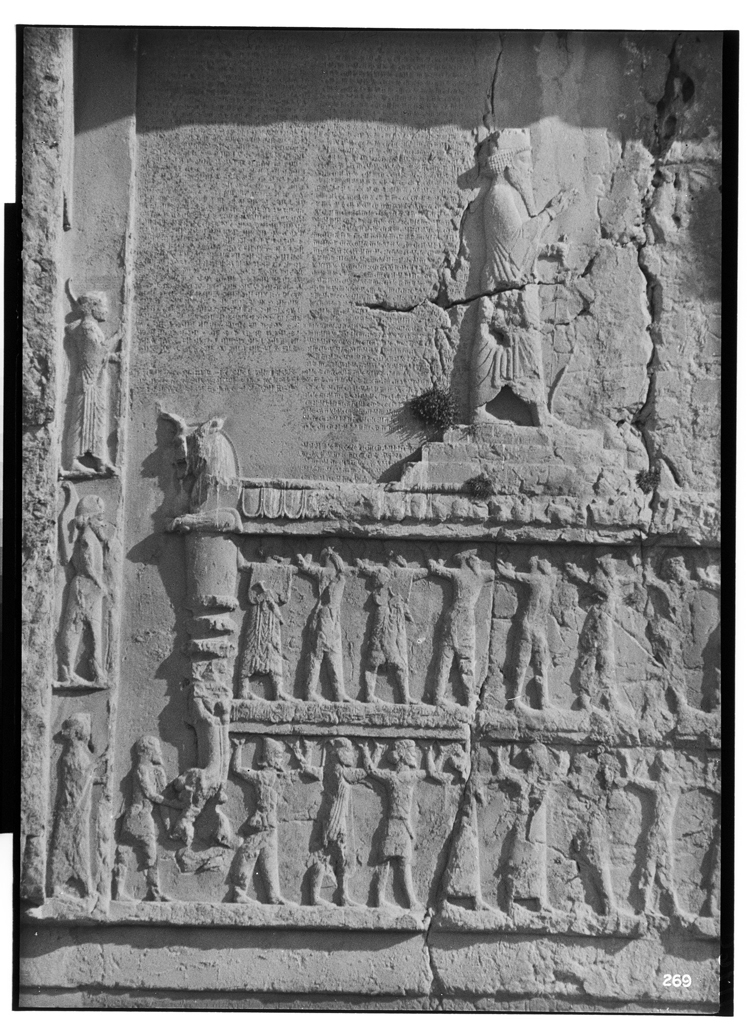2.2 DOCUMENT 2.1: The Tomb of Darius the Great, ca. 500 B.C.E.
DOCUMENT 2.1
The Tomb of Darius the Great, ca. 500 B.C.E.
The tomb of Darius the Great (r. 521–486 B.C.E.) is a monument to the king's achievements and to the power of the Persian Empire at its height. Located at Naqsh-e Rustam, an archaeological site a short distance from Persepolis, it is one of four tombs of Persian kings carved into the face of a large rock outcropping. Among other things, the sculptures and artwork depict the king, symbols of his god Ahuramazda, and the peoples under Persian rule. The following tomb-related items include a panoramic view of the tomb complex at Naqsh-e Rustam, a stone relief depicting Darius standing on a throne platform supported by conquered peoples, and an inscription in which Darius describes his empire and makes direct reference to the stone relief. As you look at the images and read the inscription, consider what they tell us about Darius's vision of empire and of his own role in creating it.

A great god [is] Ahuramazda, who created this earth, who created yonder heaven, who created man, who created happiness for man, who made Darius king, one king of many, one lord of many.
I [am] Darius the great king, king of kings, king of countries containing all kinds of men, king on this great earth far and wide, son of Hystaspes, an Achaemenid, a Persian, son of a Persian, an Aryan, having Aryan lineage.
Darius the king proclaims: By the favour of Ahuramazda these are the countries which I seized outside Persia; I ruled over them; they bore me tribute; what was said to them by me, that they did; my law—that held them (firm); Media, Elam, Parthia, Areia, Bactria, Sogdiana, Chorasmia, Drangiana, Arachosia, Sattagydia, Gandara, India, Saca who drink hauma, Saca with pointed hats, Babylonia, Assyria, Arabia, Egypt, Armenia, Cappdocia, Sardis, Ionia, Scythians who are across the sea, Thrace, petasos-wearing Ionians, Libya, Nubia, Maka, Caria.

Darius the king proclaims: Ahuramazda, when he saw this earth in commotion, thereafter bestowed it upon me, made me king; I am king. By the favour of Ahuramazda I put it in its proper place; what I said to them, that they did, as was my desire. If now you should think: ‘How many are the countries which King Darius held?', look at the sculptures (of those) who bear the throne, then shall you know, then shall it become known to you; the spear of the Persian man has gone forth far; then shall it become known to you: the Persian man has delivered battle far indeed from Persia.
Darius the king proclaims: This which has been done, all that by the favour of Ahuramazda I did. Ahuramazda bore me aid, until I had done the work. Me may Ahuramazda protect from evil, and my royal house, and this land! This I pray of Ahuramazda, this may Ahuramazda give to me!
Oh man, that which is the command of Ahuramazda, let this not seem evil to you! Do not leave the right path! Do not be disobedient!
Source: Amélie Kuhrt, ed., The Persian Empire, vol. 2 (New York: Routledge, 2007), pp. 502–503.
QUESTIONS TO CONSIDER
Question
Why might the Persians have chosen to construct the royal tombs where they did? How did the setting contribute to their grandeur? What should we make of the fact that the entrances to the tombs are high above ground level?
Question
How do the inscription and the stone relief work together to express Darius's vision of the Persian Empire? What connections did Darius make between his actions as king and the will of Ahuramazda?